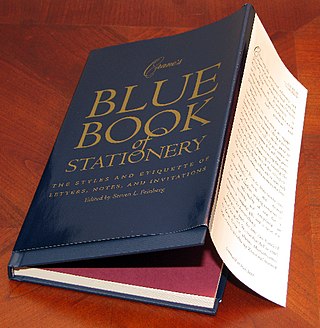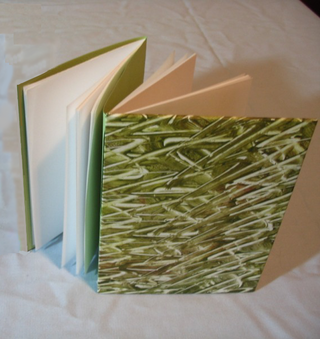
The codex was the historical ancestor format of the modern book. Technically the vast majority of modern books use the codex format of a stack of pages bound at one edge, along the side of the text. But the term "codex" is now reserved for older manuscript books, which mostly used sheets of vellum, parchment, or papyrus, rather than paper.

A hardcover, hard cover, or hardback book is one bound with rigid protective covers. It has a flexible, sewn spine which allows the book to lie flat on a surface when opened. Modern hardcovers may have the pages glued onto the spine in much the same way as paperbacks. Following the ISBN sequence numbers, books of this type may be identified by the abbreviation Hbk.

Library binding can be divided into the two major categories of "original" and "after market". The original category is as it says: the book was originally bound with the idea that it would be used in a library setting where the book would receive harder use than those usual trade editions sold to the public.

The dust jacket of a book is the detachable outer cover, usually made of paper and printed with text and illustrations. This outer cover has folded flaps that hold it to the front and back book covers; these flaps may also double as bookmarks.

Bookworm is a general name for any insect that is said to bore through books.

A treasure binding or jewelled bookbinding is a luxurious book cover using metalwork in gold or silver, jewels, or ivory, perhaps in addition to more usual bookbinding material for book covers such as leather, velvet, or other cloth. The actual bookbinding technique is the same as for other medieval books, with the folios, normally of vellum, stitched together and bound to wooden cover boards. The metal furnishings of the treasure binding are then fixed, normally by tacks, onto these boards. Treasure bindings appear to have existed from at least Late Antiquity, though there are no surviving examples from so early, and Early Medieval examples are very rare. They were less used by the end of the Middle Ages, but a few continued to be produced in the West even up to the present day, and many more in areas where Eastern Orthodoxy predominated. The bindings were mainly used on grand illuminated manuscripts, especially gospel books designed for the altar and use in church services, rather than study in the library.

Traditional Chinese bookbinding, also called stitched binding, is the method of bookbinding that the Chinese, Koreans, Japanese, and Vietnamese used before adopting the modern codex form.

In bookbinding, a dos-à-dos binding is a binding structure in which two separate books are bound together such that the fore edge of one is adjacent to the spine of the other, with a shared lower board between them serving as the back cover of both. When shelved, the spine of the book to the right faces outward, while the spine of the book to the left faces the back of the shelf; the text of both works runs head-to-tail.

Bindery refers to a studio, workshop or factory where sheets of (usually) paper are fastened together to make books, but also where gold and other decorative elements are added to the exterior of books, where boxes or slipcases for books are made and where the restoration of books is carried out.

Coptic binding or Coptic sewing comprises methods of bookbinding employed by early Christians in Egypt, the Copts, and used from as early as the 2nd century AD to the 11th century. The term is also used to describe modern bindings sewn in the same style.

In bookbinding, finishing refers to the process of decorating the outside of a book, including the lettering of the spine and covers, any additional tooling, and any inlays and onlays. Finishing can also include the gilding or other decoration of the edges of the book's pages.
In bookbinding, swell refers to the increased thickness of a textblock along its spine edge after sewing. Swell is a function of the number of sections in the book, the kind of paper used, the style of sewing, and the thickness of the sewing thread. Human factors also influence swell, especially the force with which the bookbinder "bones down", or flattens, each section after sewing.
Oversewn bindings are a type of bookbinding produced by sewing together loose leaves of paper to form a text block. Threads pass through small holes that have been punched in the signature's gutter margin, forming overlock stitches that attach it to previously attached sections. This method of stitching is sometimes called stab sewing. A piece of linen is then glued to the text block spine for further support. The book's spine may be rounded and backed to keep it from caving in, but if the text block is too thick, the spine is sometimes left flat. A strip of cloth called a super is then often affixed to the spine of the text block and then to the boards of the case. Oversewing can be done by hand but is usually done with a machine in a bindery.

Limp binding is a bookbinding method in which the book has flexible cloth, leather, vellum, or (rarely) paper sides. When the sides of the book are made of vellum, the bookbinding method is also known as limp vellum.

Bookbinding is the process of building a book, usually in codex format, from an ordered stack of paper sheets with one's hands and tools, or in modern publishing, by a series of automated processes. Firstly, one binds the sheets of papers along an edge with a thick needle and strong thread. One can also use loose-leaf rings, binding posts, twin-loop spine coils, plastic spiral coils, and plastic spine combs, but they last for a shorter time. Next, one encloses the bound stack of paper in a cover. Finally, one places an attractive cover onto the boards, and features the publisher's information and artistic decorations.

Book rebinding is the renewal or replacement of the cover of a book. Typically, this requires restitching or renewal of the glue which holds the pages in place.

The British Library contains a wide range of fine and historic bookbindings; however, books in the Library are organised primarily by subject rather than by binding so the Library has produced a guide to enable researchers to identity bindings of interest. The collection includes the oldest intact Western bookbinding, the leather binding of the 7th century St Cuthbert Gospel.

The conservation and restoration of books, manuscripts, documents, and ephemera is an activity dedicated to extending the life of items of historical and personal value made primarily from paper, parchment, and leather. When applied to cultural heritage, conservation activities are generally undertaken by a conservator. The primary goal of conservation is to extend the lifespan of the object as well as maintaining its integrity by keeping all additions reversible. Conservation of books and paper involves techniques of bookbinding, restoration, paper chemistry, and other material technologies including preservation and archival techniques.

George A. Baer was a German/Swiss/American bookbinder. He specialized in fine leather bindings, including inlays and gold tooling.

August Sandgren was a Danish bookbinder. He was one of the best craftsmen of Denmark and a great designer who never compromised with the techniques of bookbinding.


















